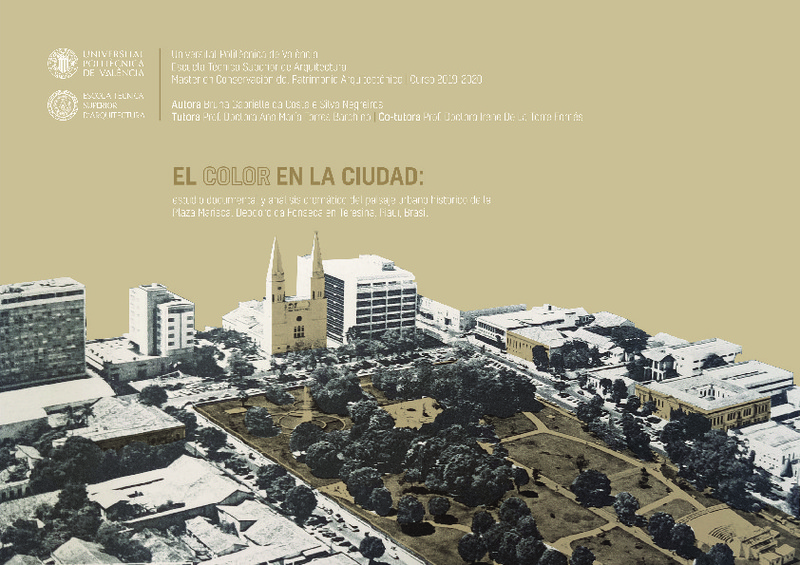|
Resumen:
|
[ES] Se tiene la convicción de que los paisajes urbanos son palimpsestos, construidos gracias al paso del tiempo, frutos de una superposición de experiencias y caracterizados por su naturaleza cambiante. Así también son ...[+]
[ES] Se tiene la convicción de que los paisajes urbanos son palimpsestos, construidos gracias al paso del tiempo, frutos de una superposición de experiencias y caracterizados por su naturaleza cambiante. Así también son los centros históricos, que se constituyen por una serie de aspectos acumulados en el transcurso del tiempo, los cuales, en conjunto, crean lo que se nombra imagen de la ciudad. Entre dichos aspectos que dan carácter a la imagen urbana está el color, objeto de interés de ese estudio.
El presente Trabajo Final de Máster, teniendo como principal objetivo la intención de contribuir para una aproximación a la imagen y a los valores históricos de los conjuntos patrimoniales urbanos y arquitectónicos, se valió del estudio de aspectos cromáticos, tomando como objeto concreto de estudio el paisaje urbano histórico de la Plaza Mariscal Deodoro da Fonseca y su entorno inmediato, el primero sector construido de la ciudad de Teresina, capital del Piauí, en el noreste del Brasil. La investigación planteada se dedica al estudio del entorno, en lo que hace referencia al color en la arquitectura patrimonial, con el fin de poner en valor una zona que, aunque de gran significancia cívica e histórica para la ciudad, actualmente ve su imagen afectada por los resultados de una urbanización acelerada y por el método de gestión llevado a cabo a lo largo del tiempo.
Para el correcto desarrollo de la investigación y alcance de sus objetivos, la metodología empleada se dividió en trabajo investigativo, trabajo de campo y trabajo de gabinete. La primera etapa parte del levantamiento bibliográfico, fotográfico y documental acerca del color en el patrimonio arquitectónico y del entorno estudiado, seguidos de su revisión crítica. Luego se inicia la segunda etapa, una visita in situ para realización de registro fotográfico, observación y vivencia del lugar. Así, en la tercera etapa, a partir de los datos obtenidos en las fases de trabajo anteriores, se proceden análisis paisajísticos, tipológicos y cromáticos, con su adecuada documentación, a fin de caracterizar y comprender el objeto estudiado para, por fin, llegarse a la deseada aproximación cromática del paisaje urbano histórico de la Plaza Mariscal Deodoro da Fonseca y su consecuente puesta en valor.
Por último se incluyen algunas reflexiones acerca del contenido producido y sus contribuciones para la ampliación del conocimiento en torno del tema del color y para la actuación práctica, especialmente en el contexto de la ciudad de Teresina. Se enmarca aún que dicha investigación podría complementarse, en momento oportuno, con la elaboración de un plano de color para el entorno estudiado.
[-]
[EN] It is well that the historic urban landscapes are palimpsests, built by the time passage, product of an overlap of experiences and characterized by your mutant nature. The historic city centres are also like that, ...[+]
[EN] It is well that the historic urban landscapes are palimpsests, built by the time passage, product of an overlap of experiences and characterized by your mutant nature. The historic city centres are also like that, made up of a series of aspects accumulated over the time, which together create what is called city image. Among such aspects that characterize the urban image is the color, topic of interest in this study work.
This Master Thesis, having as a primary aim to contribute to an approximation to the image and the historical values of urban and architectural heritage complexes, adopted the method of chromatic analysis, taking as a specific object of study the historic urban landscape of Marshal Deodoro da Fonseca Square and their immediate evironment, the first built sector of Teresina, capital of Piauí, in northeast of Brazil. The research is dedicated to the study of the historical aspects of this area, in relation to the color in architectural heritage. The aim is to highlight an area that, although of great civic and historical significance for the city, currently has their image affected by the results of an accelerated urbanization process and by the management method carried out over the years.
For the correct development of this research and the achievement of their objectives, the methodology it was organized into research work, field work and office work. The first stage starts from a bibliographic, photographic and architectural search about the topics of the architectural heritage color such as the specific area of study and their critical review. In sequence starts the second stage, an in situ visit to make a photographic record, observe and experience the place. Thereby, in the third step, from the data obtained in the previous work phases, landscape, typological and chromatic analysis are carried out, with the adequate documentation of the process, in order to characterize and understand the study object and, lastly, reach de desired chromatic approximation of the historic urban landscape of Marshal Deodoro da Fonseca Square and this consequent valorisation.
Finally, it includes some reflections of the produced material and their contribution to the expansion of knowledge around the color theme and the practical activities, especially in the urban context of Teresina. This research could still be complemented, at an opportune moment, for the elaboration of a color plan to this zone.
[-]
|







